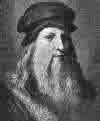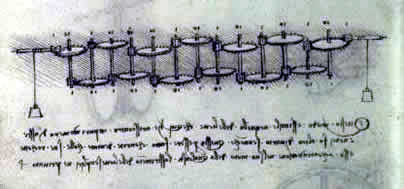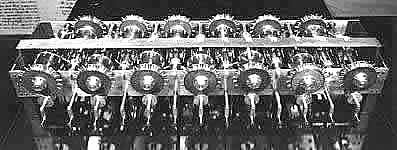click on the home button to go to the thocp home page
|
The Prehistoric Era 1310 - 1617 Europe just slipped out of the dark ages. In Asia sciences had their top days. The first mechanical calculators showed up in Europe. Leonardo Da Vinci did he really invent a mechanical calculator? Napier developed the natural Logarithm |
pre history | antiquity
| pre industrial era | industrial
era
0000 - 496
- 1310
|
|
|
|||||||||||||||
![]() The earliest
reference to computers came from a writer called Trevisa.
He wrote about "Compotystes" meaning
persons that occupied themselves with calculations of time.
The earliest
reference to computers came from a writer called Trevisa.
He wrote about "Compotystes" meaning
persons that occupied themselves with calculations of time.
![]() These
tally sticks were used by the exchequer in the UK to keep track of taxes. (see
also David
Birch's article on Tallies
and Technology)
These
tally sticks were used by the exchequer in the UK to keep track of taxes. (see
also David
Birch's article on Tallies
and Technology)
 |
|
| This was the design in his own writing. Da Vinci wrote from right to left and in reverse (you could only read it normally from a mirror). The paper or book in wich he described his device is called the "Codex" and parts of it are preserved in different museums. (2) |
 |
 This
was the reconstruction of his calculator, its present location is unknown
to the editors This
was the reconstruction of his calculator, its present location is unknown
to the editors
|
|

![]() Before
he began to work on the Last Supper, Leonardo designed and possibly built the
first humanoid robot in the
Western civilization. The robot, an outgrowth of his earliest anatomy and kinesiology
studies recorded in the Codex Huygens, was designed according to the Vitruvian
canon. This armored robot knight was designed to sit up, wave its arms, and
move its head via a flexible neck while opening and closing its anatomically
correct jaw. It may have made sounds by the use of automated drums. On the outside,
the robot is dressed in a typical German-Italian suit of armor of the late fifteenth
century. This robot would influence Da Vinci's later anatomical studies in which
he modeled the human limbs with cords to simulate tendons and muscles.(13)
Before
he began to work on the Last Supper, Leonardo designed and possibly built the
first humanoid robot in the
Western civilization. The robot, an outgrowth of his earliest anatomy and kinesiology
studies recorded in the Codex Huygens, was designed according to the Vitruvian
canon. This armored robot knight was designed to sit up, wave its arms, and
move its head via a flexible neck while opening and closing its anatomically
correct jaw. It may have made sounds by the use of automated drums. On the outside,
the robot is dressed in a typical German-Italian suit of armor of the late fifteenth
century. This robot would influence Da Vinci's later anatomical studies in which
he modeled the human limbs with cords to simulate tendons and muscles.(13)
The Peruvians had devised a simular handy gadget consisting of strings and knots, called a Quipu, to assist them with counting. They used a form of decimal notation the position and form of the knots indicated tens, hundreds, etc. (12) |
 |
 |
Peter Henlein, a craftsman from Nuremberg Germany, creates the first watch.
![]() The first spinning-wheel
became in use in Europe. This is a nice example of parallel inventions, since
these kind of wheels were also developed in India and thereabouts but much earlier.
The first spinning-wheel
became in use in Europe. This is a nice example of parallel inventions, since
these kind of wheels were also developed in India and thereabouts but much earlier.
![]() The increasing sophistication
in technology of clocks and watches resulted in making more complicated kinds
of automata during the European Renaissance. Gianello
Toriano's mandolin playing
lady is a famous example. This "clock" technology would become of
crucial importance to the further development of computer technology.
The increasing sophistication
in technology of clocks and watches resulted in making more complicated kinds
of automata during the European Renaissance. Gianello
Toriano's mandolin playing
lady is a famous example. This "clock" technology would become of
crucial importance to the further development of computer technology.
![]() Nicolaus
Copernicus published the Revolutionibus,
in which he stated that the planets and earth were moving around the sun. With
this statement he recreated the contemporary human relationship to God as this
was felt by the clergy. And as usual the authorities (i.e. the church) did not
like his 'revolutionary' vision. He had a hard time surviving in the 16th century
society, where all sciences and arts were subsidized by the clergy or nobility.
Being supported as an artist or scientist by a maecenas (well doer) is not uncommon
in this time. and the church effectively silenced Copernicus by withdrawing
her support. A method still in use by modern-day politicians.
Nicolaus
Copernicus published the Revolutionibus,
in which he stated that the planets and earth were moving around the sun. With
this statement he recreated the contemporary human relationship to God as this
was felt by the clergy. And as usual the authorities (i.e. the church) did not
like his 'revolutionary' vision. He had a hard time surviving in the 16th century
society, where all sciences and arts were subsidized by the clergy or nobility.
Being supported as an artist or scientist by a maecenas (well doer) is not uncommon
in this time. and the church effectively silenced Copernicus by withdrawing
her support. A method still in use by modern-day politicians.
![]() Joost
Buerghi (Switzerland) developed the Logarithm
table(6). This marks a milestone in the
development of mathematics. Much later it appeared that without the development
of logarithms the computer would have taken much longer to develop.
Joost
Buerghi (Switzerland) developed the Logarithm
table(6). This marks a milestone in the
development of mathematics. Much later it appeared that without the development
of logarithms the computer would have taken much longer to develop.
|
|
| William Gilbert coins the term electricity from the Greek word elecktra. |
Around this year the first clock showing minutes and seconds is built by Joseph Burghi, Switzerland
John Napier made the first printed use of the decimal point (after it had been invented in the Netherlands) and invented logarithms, and several devices for multiplication. The "bones" he invented were an aid to multiplication, though perhaps the chessboard calculator was the most ingenious and least known!
|
|
Lord John Napier published his findings on logarithms in his tractate "Mirifici Logarithmorum Canonus Descriptio" (Description of the admirable Canon of Logarithm) and influenced with this paper the entire development of mathematical science in the United Kingdom and beyond. |
| Napier's book was published posthumously : "Rabdologiae, sue Numertionis per Virgulas Libri duo" in which he explained extensively the method for division and multiplication using his "Napier Bones".(7) |
![]()
| Last Updated on 12 February, 2004 | For suggestions please mail the editors |
Footnotes & References